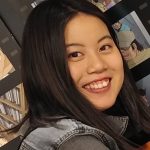Hometown in Japan: Kyoto
Home University: Doshisha University, Faculty of Life and Medical Sciences, Biomedical Engineering
B2: Sophomore, Expected Graduation Date: March 2021
Host Lab at Rice University: Robotics and Intelligent Systems Lab
Host Professor: Prof. Fathi Ghorbel, Depts. of Mechanical Engineering and Bioengineering
Research Project Poster (PDF): “Analysis of Human Gait Trails for Simulating Personalized Treatments”
Why Nakatani RIES?
I chose to join the Nakatani RIES Fellowship because I wanted to expand my sight of view. Also, I wanted to have a research experience in United States. I think I can learn and earn many things from touching the cutting-edge technology and research being conducted at Rice University. I hope that this experience will strengthen my skills as a researcher. After finishing this program and returning to Japan, I’ll be able to use my new knowledge to further my studies. I believe that this experience will help me with my decision about future graduate study and that having international research experience as an undergraduate student is very valuable. By experiencing this program, we can think of various options from a young age. Since we are going to become more familiar with US universities through this program, we will likely be able to think about options of graduate school in foreign countries more in-depth than other Japanese students can. I believe that learning in foreign countries will challenge and help us to grow. I’m most looking forward of learning more about doing engineering research. Also, I’m impressed by all of the additional opportunities to imrpove my English skills I’ll have at Rice University.
- To gain confidence and embrace challenges.
- To learn more about cutting-edge technology and research.
Nakatani RIES Program Experience
I would say that the research was the most important thing I learned though the Nakatani RIES Program. Having international research experience is very important for Japanese students because through this we can know more about what we are going to do in future, so we can be focused and our motivation for learning will rise. If we learn about how research is conducted in US, we can take the good customs from the US and bring them back to Japan so that Japanese research will grow.
After completing the Nakatani RIES Program, I became more of an information seeker. Before joining this program, maybe I ignored new information and didn’t seek out new chances in my home university (or perhaps there were less opportunities available for freshmen). Now that I’ve come back, I’ve started to recognize there were many seminars going on in the campus. I never realized that before during the spring semester.
To other Japanese students interested in the Nakatani RIES program I would say – just try it! There is no reason not to pursue the challenge to apply to this program. You can make friends from all over Japan, America, and around the world. You have to do work hard, but the experience you will get is worth that work.
- My favorite experience in the U.S. was … spending time in Washington, D.C. Overall, I liked the city atmosphere. The Metro was cleaner and more convenient in D.C. than in Houston, and we didn’t need to have a car to get around.
- Before I left for U.S. … I wish I had to read more thesis and papers related to my research topic. My mentor said I didn’t need to read them, but I felt that if I had read the thesis, I might have been able to conduct the research better.
- While I was in the U.S. I wish I had … a chance to visit other labs from the Department of Mechanical Engineering. I tried to contact other labs’ members, but they never gave me a chance to visit, so I was sad about that.
Excerpts from Chiaki’s Weekly Reports
- Week 01: Arrival in the U.S.
- Week 02: First Week in My Research Lab at Rice
- Week 03: Interview with U.S. Student and Researcher
- Week 04: Reflections on English Language & Life in the U.S.
- Week 05: Final Week at Rice and Research in the U.S. vs. Research in Japan
- Research Project Overview and Poster
- Week 06: Last Week in the U.S.
- Final Report
- Tips for Future Participants
Week 01: Arrival in the U.S.
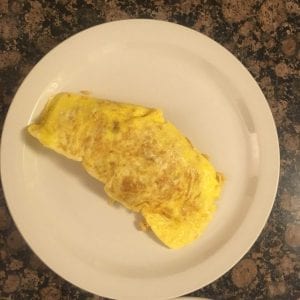
Before I left for the U.S., I brought many hundred-yen shop goods to prepare my food. It helped me to cook since it was more convenient. I suggest bringing a small microwavable rice cooker, Japanese tea bag , and instant miso soup just in case you might really miss Japanese food. I missed Japanese food when I arrived so I tried to cook an omelet (オムライス) using these items. These were very helpful items and are very cheap, so I recommend bringing them. Also, bring some washing tools such as laundry scissors and hangers. The hotel room is dry, so you can just hang your laundry in your room and it will dry soon.
As for my initial reactions when I arrived in Houston, everything was huge. This is my third time to be in U.S., and I like to being in U.S. I was surprised that many airport employees are helping disabled people and it seems to be normal for Americans. In Japan, services for the disabled are now improving than before but still, I don’t see many disabled people traveling around. This is because the support for the disabled people is not strong enough yet. I hope that situation will be better in near future. In addition, I was surprised how restrooms were clean. When I went to Boston three years ago, restrooms in the airport were dirty and not clean, and had a quite similar situation in other public restrooms too. I was thinking that the restrooms would be dirty when I arrived, so when I saw the restrooms in the Houston George Bush International Airport (IAH), I was so surprised. At Rice University, all the restrooms were clean too.
During my first week at Rice University, we had many orientation activities. The Campus Tour held by Welcome Center was very interesting. We get to know many trivia and fun facts about campus. I especially liked the story of the group of students changing the direction of William Marsh Rice’s statue and the frog wall story at the Architecture building. The seminar on Tips on Using/Speaking in English held by Prof. Ozaki was also very interesting. I knew about the rhythm of pronunciation, but after this lecture I could structurally understand the way Americans talk and how this is different from what normal Japanese people talk like. This lecture was very helpful for me to talk in more professional and easy-to-hear English. The Introduction to Designing a Research Poster held by Dr. Gayle Moran was also very interesting. I have never made a poster before, so I was glad to have this opportunity to help us create the poster. She showed us many good examples and bad examples. I want to be creative and make a well-prepared poster. Overall, my favorite was the campus tour. We get to know the location of the buildings and I felt like I am the part of being a new student here at Rice.
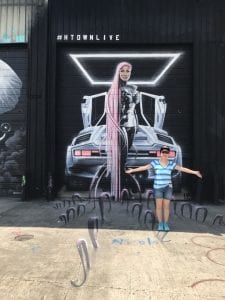
The evening grocery store tours at Randall’s and H-mart were very exciting. Even though we didn’t buy a lot of stuff in comparison to students in some of the other rooms, it was a fun time. I get to know how Houstonians eat, shop in their daily lives, and at H-mart I found many Japanese foods, snacks and drinks. However, all the Japanese foods were double-priced since they are imported to the U.S., so I just bought a pack of rice. The Houston Mural Tour on Saturday was very interesting. I didn’t know that there were many official murals painted on the wall and the building. They were very artistic and fun to look at. I followed some mural artists on Instagram too. The Houston Food Fest was also interesting. I could test wide range of foods and drinks. It was seriously hot, but the food was awesome. We ate a lot! After that, we went to Hard Rock Café and I bought drumsticks. I really liked the design. And then, we took Uber to go to The Galleria for some shopping. I spent a lot of money buying some random clothes and personal needs
On Sunday, my mentor took me and two JP fellows Salt Grass, a steak restaurant. The steak was big and very juicy. And then, we did some shopping at Target. It was like AEON in Japan. I bought some cosmetics that were cheaper than in Japan.
Reflections on Intercultural Experiences
I strongly sensed the American core value of self-reliance when I’m doing the research. When I asked my mentor how in-depth I should research on my topic and he said, “It’s up to you”. That means, if I could afford to spend more time on certain aspects, my poster will be nicer and if I couldn’t, my poster might be poor. My mentor is ethnically Chinese, but he has studied in US for a year, so I thought he has become familiar with US core value too. The core US values are not only Americans have in common, but all people who are living in US has in common.
When my mentor said, “it’s up to you”, for me as Japanese, it meant “put your best effort and work as hard as you can”. I have this cogitation probably because I am Japanese. Normally Japanese are considered hard-workers and work for a long time on the project. I personally think that efficiency is the most important thing in life, but to make time more efficient, hard work is necessary. We must think of more efficient ways to do the task more quickly and correctly. It is like writing a code in programming. To run a program fast, you should use a loop and other useful keys to make it simpler. On the other hand, the Japanese old style of hard work is like running an old fashioned, non-protected, slow, long and complicated code.
Preparing for Research in the U.S.
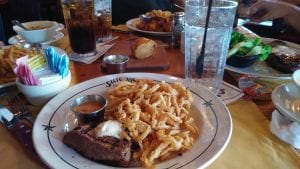
Before coming to the U.S., I downloaded some software that is used in the laboratory. The hotel Wi-Fi was a little bit slow, so I recommend downloading the software prior to departure in Japan. You just need to use your Rice University NetID and your password to login to have access to some of the free student software licenses of Rice. You can download a couple of expensive software programs from that page.
My first few days in lab started more slowly than I was expecting. I was thinking that I’m going to do some simulations right after I arrived, but the in fact it was different. To do the simulation, we must first know the mechanism of the motion and how to utilize the software. So, I started learning how to use Matlab and Opensim. Opensim is used to adjust the data from experiments to the modelized person. Matlab is used to analyze the data from experiments. It also can be used to transform the coordinates to fit the model. I learned some basic codes and my mentor gave me several basic problems to learn more deeply, and I tried to work on them by myself. When something was unclear, I could ask my mentor anything anytime since his desk is right next to me. He helped me a lot and gave me some good advice.
I think I learned and absorbed many things in these few days at lab, and I expect that I’m going to learn more about how to create the model or how to simulate using Opensim in the next week. I have some advices for future participants. One is to bring a mathematics text book in Japanese. If you are in the computer science or mechanical engineering, you will need many mathematical elements to solve the problem and do your research. Math is the basis of all sciences. So, remember that please if you’re in those laboratories. I couldn’t bring the textbook in Japanese because my suitcase was so full, but it will be convenient and useful to have a math textbook. I borrowed the English mathematics textbook from my mentor, but some of the words were difficult and there were many words that I didn’t know the definitions of in English. Second, is to email your professor or your mentor several times. I haven’t got a reply from my professor for about three weeks, so I sent the another one and then I sent the third email three days later and finally he replied back to my email. I think that I should have sent the follow up email sooner, not just waiting for the reply. Then, I could have more time preparing for my research. Please keep this in mind this as well.
Last is to try by yourself at the first. It is okay to ask anything that is unclear to your mentor and to your professor. They’re happy to help you. On the other hand, it is important to try to solve the problem by ourselves. In future, you must design your original experiments and simulations by yourself. It will be hard if you didn’t have an experience, but try your best without any help. You can ask questions if you need to, but at the same time you must think about be innovative and challenging.
Week 02: Life in My Research Lab at Rice
I met my host professor, Prof. Ghorbel, for the first time on last Friday. He is a very nice person. My mentor is also working with Prof. Fregly, so I had the opportunity to sit in on his class on simulation using Opensim. His lecture was clear and very relavent to my research topic, so it was very helpful for me.
My mentor, Sichao Zhang, is 2nd year Master’s student. He has been at Rice University since last year and he is from China. Since I sit next to him in the lab, he always guides me and helps me figuring out the bugs in my codes. My host lab, RiSYS (which stands for Robotics and Intelligent Systems) lab has three members; a 5th year PhD student, my mentor and a 1st year Master student. It is a small lab, so we have a lot of flexibility with time. I usually arrive at around ten o’clock every day and I leave between four o’clock and five o’clock. For lunch, we usually go to Sammy’s or FLO Paris on our own or with my mentor and sometimes his girlfriend too. Both are on the campus and you can eat delicious sandwiches and hamburgers for less than ten dollars. I strongly recommend a hamburger with sautéed mushrooms, onions and fried potatoes at Sammy’s. I love to go there and take a refreshing break from the lab.
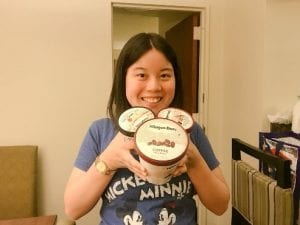
It is very hard for me listening to non-native English speakers’ English. I was not familiar with my mentor’s intonation in English, so it is very difficult. I noticed that not only native speakers are speaking English. It is strange that I haven’t realized this before since I too AM a non-native English speaker. Students come to Rice University from many places in the world and they speak English with a diversity of accents. I was and still am struggling with those accents and they often talk fast! If you couldn’t understand what they said, I’ve learned just to ask them to repeat. It will always happen, even when we are in Japan. You don’t have to hesitate to ask them. I don’t think this is something you can prepare for but you’ll get used to hearing non-native English speakers speaking in English over time.
I enjoyed the panel discussion held by Japanese graduate students in Rice University. I was able to learn about many facts or tips on applying for the US graduate schools. I asked many questions and it was very interesting to listen to their words. Dr. Motomura’s talk was also very interesting. His company is working on the artificial heart pomp Evaheart and I was very excited to listen to him speaking. Visiting NASA Johnson Space Center was a fantastic experience for me. However, I think I needed more time to look around. I was surprised that NASA was very common place for Japanese to go and I saw many Japanese visiting there. We joined the tour to go to the training center. We could see Orion and many other facilities used for astronauts’ trainings. Also, I bought many NASA items for my family and myself for gifts. .
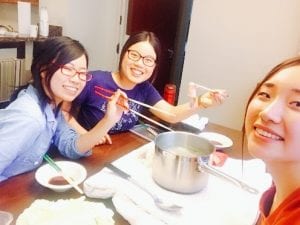
On Tuesday, we went to the farmer’s market at Rice University. We could buy fresh eggs, delicious breads, meats, jams and cookies. After that, we made Shabu Shabu in the hotel room. We bought Shabu Pork, Ponzu, cabbage, and Tofu at H-mart and ate them all. We all enjoyed Shabu Shabu and it was delicious! We are planning to do that again at someday. We also went to Houston Premium Outlet on Sunday. It was about forty minutes ride by Uber/Lift but everything was so cheap and many kinds of shops were there. The shop employees are usually very friendly and kind. If you don’t want to have a conversation, just say “I’m just looking around”, then they’ll notice that you need more space. Honestly, it is much better to answer them and enjoy the conversation. You can show that you can understand English well so that when you’re at the cashier, you can purchase items smoothly. Also, you can enjoy chatting with your Uber/Lift driver too. They know a lot about Houston and the U.S. so ask them for advice on some places to go.
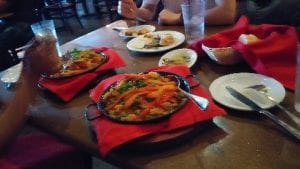
For daily life, I cook breakfast (usually sandwiches or cereals) and dinner almost everyday and on weekends and Friday night, we usually go out and eat at different restaurants. We went to eat paellas this Friday night. Rice Village is a nice place to shop and eat. It is near to the campus and you can take the hotel shuttle or Rice University shuttle to get there.
Research Project Overview
In my lab, we mainly use computers to create models and calculate force. Last week, I was only using computers and writing a code, then using MatLab to generate the code and adjust the data to make them useable in Opensim. I will need to complete learning and becoming familiar using the software Opensim to run the simulation. I’m still working on this and from next week, I’m hoping to start the simulation.
On Monday, when I was trying to apply Inverse Dynamics to the model on the Opensim, strange errors happened, and the code didn’t work well. Then, I checked all my steps again and I found out that I missed the time data, so I fixed that. Then, a different error message appeared. My mentor said that at least I was able to take logical step and follow my progress to troubleshoot. Since the software found out the different problem, it means that I solved the more basic problem at the first point. And then, I tried and tried to solve the bug, but the same error message kept appeared. We decided to use my mentor’s data and Inverse Dynamics Setting file instead of mine. Then, it successfully worked! I have a little regret that I couldn’t investigate the cause of this bug, but we continued working on. Inverse Dynamics is a method for computing forces and torques based on the motion of a body.
On Tuesday, my mentor told me to read a textbook about the theory of Inverse Kinematics. Inverse Kinematics is a method to determine the parameters of each robot arms and provide a desired position of the robot arm’s end-effector. I started reading the textbook and tried to understand the theory, but it was complicated and took me long time to understand that. On Wednesday, we had a little discussion about how we are going to approach our research. We still don’t have a detailed plan, but my mentor and I were planning to work on Static Optimization and Inverse Dynamics on this week. In the next week, we are planning to work on Residual Reduction Algorithm and adding spring on to the model. Residual Reduction Algorithm is used to minimize the effects of modeling and marker data processing errors that cause the huge error when processing the data afterwards. From Thursday, I started working on Static Optimization. Static Optimization is an extension to inverse dynamics that further resolves the net joint moments into individual muscle forces at each unit time. The purpose of applying these steps to the data is to have a more accurate and clearer gait model. All these steps can be run in Opensim, and all I must be aware is its setup file to input the corresponding data.
If I have any questions or something unclear, I will try to ask my mentor as soon as possible. If you have a clear goal in mind and just keep trying to reach that goal, you must think about it first and then ask your mentor.
Week 03: Interview with a U.S. Student and Researcher
I had a great opportunity to hold an interview with Prof. B. J. Fregly. He is a Professor of Mechanical Engineering & Bioengineering and the director of the Rice Computational Neuromechanics Lab. I had the opportunity to interview him because my mentor runs his research with Prof. Fregly too and my mentor and I sit in together in his class.
“Why did you decided to go to France and receive a Châteaubriand Post-doctoral Fellowship?”
He decided to go to France because he just wanted to go. He said that when he visited Europe after the senior year of his undergraduate school, he heard his French friend speaks French, and he thought that French was a very beautiful language. And then, he decided to take a French class during graduate school. During graduate school, he met another French friend and that friend helped him with his French. His friend gave him an information about the Châteaubriand Post-doctoral Fellowship program. When Dr. Fregly finished with his Ph.D. degree, he decided to apply for that program, and he was selected. He did a one-month language training in France (since he had learned French for only one year) and he worked in France for a year. He tried to interact only in French with French people, so his French got better, he made lots of friends, and really enjoyed the life there.
“Why did you decide to work as a software developer and what did you learn from that experience?”
When he was in 8th grade, his uncle, who was a professor at the University of Florida, told him that “it is very rare to meet the professor who doesn’t love what he does”, and he thought that was interesting, and remembered those words even now. When he got older he realized that it is rare to meet office workers who love their jobs, but professors loved what they do. And then, he realized that he loves to interact with university students, so he wants to be a professor. And to be a good professor, he and his wife thought that it would be valuable for students, to have experience as an employee at the company. Since most of students will go to work in industry after they graduate, he thought they will feel that they want to have an advisor who knows about industry.
This experience gave him a lot of real-life experience which most professors don’t have. The first two years weren’t challenging but were frustrating because he was just doing a quality testing job and it was a job that he desired to do. Then, he did a good job on quality testing, so he moved to software research development which is more challenging. When he was working as a software developer, he faced a lot of difficulties and learned many things or techniques which have now helped him in his research. Also, he built some great connections with his previous colleagues and still has a good relationship with them in his research.
“Why did you choose Rice University?”
As he said before, he loves to work with university students. He thought working at Rice will be good because they have a residential college system and he and his wife oversees one of the colleges and get to live on campus. They have more student interactions and more collaborations than before.
“What do you think of international students coming to study in United States, and do you have any advice for them?”
It is a good thing to having many international students. The best American students often don’t go to graduate school because they can get highly-paid jobs right after they graduate from university. Universities and professors want to have good students to get Ph.D. positions and they thing drawing great international students to fill in that position is valuable. It is the truth that some professors tend to take too many students from their home country, but most American professors don’t do that. He said he wants to have best students who can fit in the lab and communicate well. For advice, he said be an excellent English speaker/writer. Professors are willing to have a researcher who can write a journal in English well so that they don’t have to rewrite it for the student. Keep up working on English and be an excellent speaker/writer if you want to apply for the graduate school in the United States.
Reflections on the Interview
I thought he really thinks about his students first. From his episode about going to work in industry to build up a special career as a professor, he always thinks about students. I could feel that from his every word, and his lectures were very clear. He listens and answers kindly to his students even when the class is over. I loved that attitude because in Japan there are many professors who don’t pay attention to trying to hold an exciting class at all, don’t answer student’s question, or when they’re listening, they try to hurry students to finish up with his/her question which is very uncomfortable for the students. I felt Prof. Fregly and other Rice professors never do such things. It was very nice time having a conversation with him. I appreciate Prof. Fregly to taking his precious time to talk to me.
Interview with a Graduate Student
I also had an interview with Jun Ge, who is a first year Master of Science student in our lab. He came to Rice several weeks ago, and he joined the RiSYS lab recently. He is from China and he finished his undergraduate study in Taiwan.
“Why did you chose to study in United States?”
He thought that the research level in the United States is the top of the world, in technology, resources, people, and opportunity. Unlike in Taiwan, which hasn’t been changed from 14 years ago, the United States is continuously changing and developing, so he thought studying in the U.S. is more challenging and exciting.
When he was a Junior High School student, he went to Atlanta and performed in a Chinese traditional play in his school band. He was also a big fan of NBA and when he was travelling in New York and Los Angeles, and he felt that he likes to be in the United States and he wanted to come back to the United States again.
“How is it being a Rice student?”
He said he is enjoying the life in Rice. He chose to apply to Rice because every professor has more focus on their students. Class size is small, professors know what students are doing, and are always helping students.
“Any advice for undergraduate students?”
He said that most important thing is to be brave. Be brave and speak out your mind and express yourself in English. If you’ll be brave, you can improve your English faster. It is important to speak and write well in English, and to accomplish that, you will have to be brave.
I also interviewed a Ph.D. student in my lab and he gave a similar reason for why he came to U.S. They both said we have great opportunity in the United States but in their home country, they can’t get that opportunity as much as in the United States. It as very interesting that they came to U.S. from different countries, but with same reason. I thought good students want to go to U.S. because the best students from almost every country comes to U.S. to study, and the best students will be taught by best researchers, so the United States will have many good researchers in many academic fields. So, I thought that if Japanese researchers develop research more and widen the opportunities, maybe more researchers in Japan will remain in Japan and do research.
Labor Day Holiday Weekend
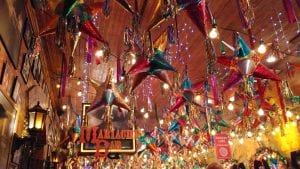
During the Labor Day weekend, we went to San Antonio. We went to the Mission Trail (Mission Conception, San Jose, San Juan and Espada). All of the Missions had a church and the churches were all beautiful in different ways. One of them was very bright and colorful, one of them was cute, one of them was old but historical, all had different atmospheres but all were really spiritual and I really liked them. Since I was at a Mission School when I was in Kindergarten and Elementary school and learned Christianity from Junior High School to now, I’m very familiar with chapels, churches, and cathedrals. Even though I’m familiar with them, I haven’t seen such devout Roman Catholic praying in the church, so I was very surprised.
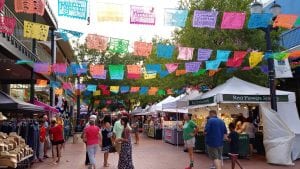
We ate dinner at Mi Tierra and the dishes were very delicious. Many piñatas were hung inside the restaurant which is very cute and instagood! I recommend eating here but unfortunately you must wait for about an hour – but it’s worth waiting for. The Market Square was also very cute and fun to look around. There are many Mexican shops and Latin music performances held in the square. If you saw Disney movie “COCO” (in Japan, “Remember me”), this is what it looks like. I really enjoyed the music and the atmosphere.
When I was walking around along the River Walk, I surprisingly met three JP fellows and we ate lunch together, went to the River Walk Boat Tour, and went to the Tower of America. The view from there was excellent, especially at night. I really recommend going there. I was learning Spanish before so the language, culture, people were familiar with me. However, they talked fast, so I couldn’t understand what they were saying. I will try to remember my Spanish skill as well as my English skills in the future. It was relaxing and fun time at San Antonio. I might visit there in future.
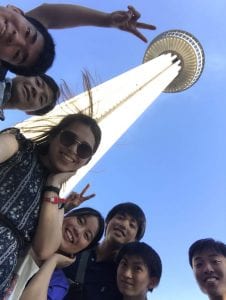
Research Project Overview
I was stuck working on Reduce Residual Algorithm bugs the whole week and couldn’t do more research this week. Nothing worked well this week, so I was very frustrated and mad at myself when I couldn’t handle this single problem. I started to shift change on doing Static Optimization again since Reduce Residual Algorhythm doesn’t work at all. Maybe there is something wrong happening in the setup file which I made. It can’t be saved properly so I have to type the setting file each time I run the program which is very annoying.
On Thursday, I started on adding a spring on the model’s ankle to support its movement and do the Static Optimization again, but it didn’t work properly either. I was not sure, but probably there are OpenSim bugs which has irregular units causing this problem or I did something completely wrong. I think I’m getting better at trouble shooting but lots and lots of bugs come again and again. This was very tiring.
From after Labor Day weekend, I will try using Open Sim ver3.3 which has fewer bugs compared with ver4.0 and see if Static Optimization and adding a spring to the ankle works or not. I hope this will work well.
Week 04: Reflections on English Language & Life in the U.S.
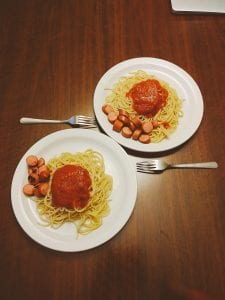
I think I’m used to my mentor’s English and I can now notice the pattern of his pronunciation. I’m also trying to exclude my strange accent as much as I can and trying to speak clear English that everyone can understand. Within my daily life, I’m enjoying the little chats I have with people I meet – or small talk. At the hotel, I say “hello” or something when I see the hotel clerk and staff and in the elevator, I sometimes say “hi” and “goodbye” when the atmosphere was friendly or when somebody said “hi” to me. It is a hotel, so not all the people are friendly like most Texans are.
I am still having a hard time on listening to Mexican-English and African-English when I hear it spoken in the city. It is also hard for me to listen to native speakers’ English which is usually very fast, so I sometimes ask them to repeat such as at the Student Center Coffee House and shops in general. In my class, I often couldn’t understand specific words so I couldn’t understand the whole statement of what the professor was saying, but when I looked up the word on in a dictionary, it was a very basic word, like 原点 ”origin”. Sometimes it is easy to guess what it means from the word itself, so try guess when you don’t have a dictionary with you, and immediately look it up in your dictionary if you have it with you to not waste your precious time.
Everyday experience is challenging for me. Nobody can speak Japanese around me in my lab and in my class. On the other hand, I’m excited by this situation too. I can be brave and face any challenge because nobody basically knows me, and nobody will care about me if I do something strange. I want future Nakatani RIES participants to be brave and face these challenge openly since you will lose nothing but earn a special experience.
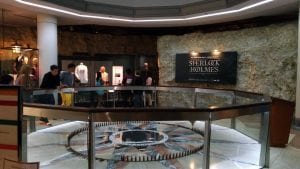
I feel successful or happy when I could clearly share my opinions with those I’m communicating with. I feel that even when I’m speaking Japanese it is hard to tell exactly what I want to say. I have no techniques to be successful at this, but I try to be open when I’m speaking and having a conversation with people; especially in the United States. People in the United States are typically open-minded to other people. Also, I try to use gestures and body language to tell my thinking.
The seminar held by CWOVC about English Idioms this week was very interesting. I had never realized that I’m using phrasal verbs in my writing before. I was just using it without noticing each word’s literal meaning and that the phrasal meaning was different. I was very surprised with that. I want to know more about English idioms, so I’ll pay more attention to what people say from now on.
- You may also want to see the Idioms section on our English Language Resources page
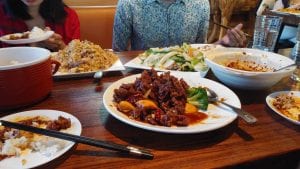
On Saturday, we went to eat American-Chinese food. It was a bit spicy but delicious. We also went to Café Brasil and enjoyed coffee and sundaes, then we went to Trader Joes to buy some groceries. On Sunday, I went to the Houston Museum of Natural Science and saw a special exhibit International Exhibition of Sherlock Homes which I really enjoyed. I enjoyed the adventure of looking for clues and I could find out the truth! Also, I enjoyed the general exhibitions too and it is free for those with a Rice Student ID. I strongly recommend visiting there. You can know more about the history, climates of Texas, dinosaurs, human evolution, and about Egypt. I’m sure that all scientists will enjoy it.
Research Project Update
This week, I switched the OpenSim version 3.3 from 4.0. This change led me to creating the model more smoothly and concisely. I should have been using version 3.3 from before! I wasted lots of time using 4.0, but I think or I believe that this experience of debugging will be something precious for me in future. I had many difficulties in my research such as codes not working well, software bugs, and simulations kept stopping. First, I just struggled and had no idea how to debug it, so I asked my mentor fot some clues. After I had some hints from him, I started to work on the problems by myself. To be honest, most of the problems were quite easy to debug. We are human, so we are not perfect. We made some silly mistakes.
I started analyzing and comparing the result of Static Optimization between models which has an ankle spring or not to see how the applied forces are different. I carefully picked up the results of Static Optimization on individual muscle and muscle groups which are related to walking. I picked those muscles and plotted them on the line graph to see how the force was changed by time. It was interesting that I can see the model movement and forces clearly matched. It is normal thing to happen, but I was happy that it means my Static Optimization worked well. At the same time, I was relieved that I could have some key points to show in my poster session.
I started working on my poster and I tried to make my poster simple and stylish. I’m not sure about how the poster session is going to be held but I’ll put my best effort on this.
Week 05: Last Week at Rice and Research in the U.S. vs. Japan
Final Week of Research
We tested on using OpenSim ver3.3, and it worked better so I applied an ankle spring on my simulated model and see how it affects the muscle forces. When I finished my poster, I was misreading the instruction of OpenSim and thought I applied ankle spring on both ankles, but it was applying the spring just on the right ankle. I realized that mistake on the day before the poster session, so I couldn’t make any changes. I realized I must read all the descriptions more carefully.
I didn’t have a farewell party or dinner, but I handed the souvenirs I brought from Japan to the lab members and I thanked all of them for hosting and supporting me. They all gave me some heartful comments to me. Since I am still sophomore student, I have a vague interest that I want to do robotics, but I haven’t decided my specific field of interest yet. My mentor said I must learn more about robotics and find out which field of robotics I want to be expert on. I felt that my interest towards robotics has increased thorough my research experience at Rice University. I want to know more about robotics and be familiar with it.
Expectations vs. Reality of Research
I was expecting that my lab work would require more group work but the reality was different. I also thought we would have more meetings or eat lunch together and do other activities outside of the lab together too. However, our lab is very independent, and we were all working on a different project. In my group, we had only three people in the lab, so having a shared understanding was quite easy for us. Without having a shared understanding, it is impossible to achieve a great result in research. That is a good thing but since we have only one person on each project, it was also maybe hard to have a creative ideas based on group discussion.
My lab was very individualized and how you worked each day depending on yourself. We rarely had conversation with each other when we were at the lab, even though we are in the same big room. When I first came into the lab, I thought it was too quiet and was tense. However, this silent environment was precious when I wanted to concentrate on my work. My mentor said that it is okay to take my laptop outside of the lab and work on my research too. I didn’t do that because I often had to ask questions of my mentor if there was a problem. Maybe I wasn’t so independent and always wanted more knowledge or help debugging from my mentor. Next time, I should be more independent not rely as much on my mentor.
My research experience at Rice led me to think more about Robotics. Also, I got more interested in applying for a Ph.D. program at the United States through this research experience too. I realized that it is very hard to stay focused on something for a long time though. Since my laboratory was very individualized, it depended on me to work hard or not. I could spend my whole day in the lab, or I can come in at eleven o’clock and leave at the three o’clock; either way. To be honest, my life style was 30% coming early leaving late but 70% was coming late leaving early. One of the reasons for this was that I had many seminars or working lunches for this program. However, thinking back at that time, I thought maybe I could have spent more time in the lab to do more research. Maybe I couldn’t always put my best effort forward during this program. Maybe my work time was not enough. There were sometimes that my research kept stopping and didn’t work, so I felt I would just leave the lab early so that I can be more refreshed the next day. It will work in long-term research, but this was only a five-week research experience. Maybe I had to work on the problem even though I was stuck and try harder to find out what was wrong. For applying Reduce Residual Algorhythm (RRA), so many errors occurred, and I couldn’t make the result using RRA. If I had worked harder on the project, maybe I could have gotten an RRA result too. There were many things that I do not necessarily regret, but have to think about it in future. It is possible to reflect on these thoughts during my senior thesis project too.
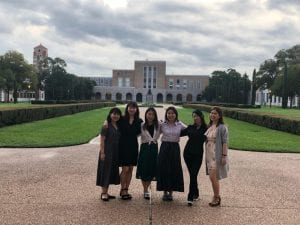
I knew before that I am do not have an academic personality, but now I clearly notice that my characteristics doesn’t fit in the academia. I think I can’t be focused on the research if I don’t have any clear deadlines or goals. I want to work as an industrial engineer or researcher after I complete from graduate school. I think I’ll get at least Master’s degree in Japan and have to think about my career path again. I had an interest in applying for graduate school in the United States before I came here so it means, my plan hasn’t changed but I am now encouraged by this program.
I will surely miss the United States’ atmosphere but not Houston in particular. However, I will miss my friends at Rice. Even though I was at Rice for only five weeks, I met many people and made many friends here. They were all very nice and kind to us. At the Japanese language table, I made a lot of new friends. I become good friend with a Chinese undergraduate student who loves the same Japanese idol group as me. We exchanged LINE, talked, and hung out together. I also become friends with someone who spoke Japanese very fluently. We chatted even in Japanese without any difficulties. It is very fun to have conversation in both Japanese and English. Also, I will miss the hamburger at Sammy’s. It was delicious and has a lot of flavors.
Other Activities at Rice University
This week, we took a tour of the Texas Medical Center Innovation Institute that was interesting. I got to know one way to start up the company. I was surprised that sometimes you make a company prior to developing and expanding the idea or technology. I thought the supportive style of the Innovation Institute was great and it gives opportunities to a lot of people who wants to succeed. The poster presentation coaching was also helpful for us to build up our poster presentation skills. I learned lot of things from staffs from CWOVC and feedback from other students. I could know that I have to hear the opinions from many people, not only from my mentor. If I kept obeying to my mentor, the poster might be too complicated for other fields’ experts and hard to read.
At the hotel room, some of us gathered and practiced of the poster session on Wednesday and Thursday night. It was fun to listen to other peoples’ presentations and they gave me lots of feedback. We could know which part of presentation was difficult to understand or unclear. It is valuable to have non-experts’ opinions since lots of audience members are not from our lab and not familiar with my project. Overall, I enjoyed the poster session. It was my first time doing or even attending the poster session, so I was nervous on Thursday night. I couldn’t practice a lot and I was repeating same thing just with different wording. It is just a waste of time, as I didn’t want to be so repetitive, so we practiced at midnight in the hotel room.
Research Project Overview and Poster
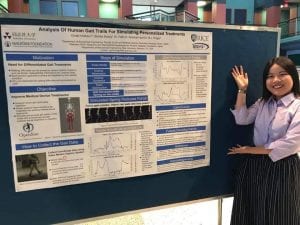
During the poster session, I made an effort to clearly talk about my project to many people. I also thought that actual location of my poster in the room also impacted the number of people who stopped by. Since I put up my poster last, I couldn’t choose the place. It was sandwiched between two poster board and located on the back side of the room, so there were less people coming compared with posters that were located on the front side of the room. However, since the poster session started, many people came to see my poster. It was hard to tell which person came – a professor, post-doc or students – so it was hard to know in which level presentation I should give to to each person. I tried to answer their questions as much as I could, but they often asked me the question that I have never thought of. I was shocked and confused when they asked those kinds of questions. I used my brain to find out the answer, but when I asked my mentor for the answer afterwards, he said that my answer were wrong. I was upset that I couldn’t answer simple questions asked by people from different major. I thought it is difficult to be a true expert in a certain field. I was very tired when have I talked to ten people all at the same time. It was hard to create a welcoming face all the time and keep a good attitude. One of the judges came when I was tired, so my brain was not working well, and I couldn’t explain my project well. I knew what I wanted to say inside my head, but I was too tired to say the words clearly out loud. I think that was also a problem.
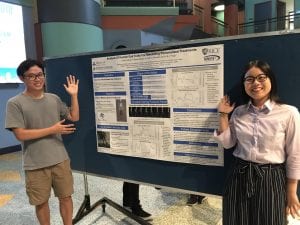
Research Project Poster (PDF): “Analysis of Human Gait Trails for Simulating Personalized Treatments”
Host Lab at Rice University: Robotics and Intelligent Systems Lab
Host Professor: Prof. Fathi Ghorbel, Depts. of Mechanical Engineering and Bioengineering
Research Mentor: Sichao Zhang, who is a 2nd year master student.
There are many patients suffering from walking problems from various causes. All patients walk differently so we have to treat them differently and personalize medical care. To design a personalized wearable device for each patient, simulating the effectiveness of the device is an efficient means of personalizing treatment.
First, I conducted an experiment to collect a patient’s static and gait data. We used a motion capture system to collect marker data on each joint and the ground reaction force from plates set on the floor to measure the force exerted on the plate. Motion Capture System will calculate the 3rd dimensional coordinate data of each joints. Unfortunately, I couldn’t join the experimental phase of the project, so I used experimental data from a previous experiment.
I used OpenSim software to analyze the gait trail and do the simulations. I used the human model provided on OpenSim. First, I scaled the static marker data on each joint and applied that data onto the OpenSim model. By adding and adjusting the static marker data of the patient, we can make the OpenSim model personalized to each patient. Then, I loaded the gait marker data from the experimental data to do Inverse Dynamics. Inverse Dynamics is the metrology to get the result of how each joint moved. Then, I added the ground reaction force onto the Inverse Dynamics result and do Inverse Dynamics. Inverse Dynamics is the way to get each joints’ moments/torques. Then, I did Static Optimization by adding Inverse Kinematics result, Ground Reaction Force, and Actuator. Static Optimization is another more accurate way of Inverse Dynamics. Actuator is the one role of muscle, which works like motors. The numbers of muscles are more than numbers of degree of freedom on each joint. Thus, we apply Static Optimization which is adding some restrictions or equations to find out the best possible result on each muscles’ muscle forces.
This is the ended my analysis of the experimental data. After that, I applied an ankle spring on the right ankle and did Static Optimization again to see how it reduced the muscle force on leg. There was a sample code adding the ankle spring on to the model on OpenSim confluence (tutorial), so I used that as a sample treatment. As a result, adding an ankle spring reduced the muscle force on many parts of the leg. Which means the subject can move its leg with small force.
I plotted the Static Optimization results of many parts of body and picked figurative results on the poster. I compared right and left leg to see the difference. The muscle force on right leg decreased but left didn’t. Also, I wanted to point out that the muscle force on each leg matched the movement of each leg which is normal, but it meant the simulation worked well. I also compared toe bending force and Gastrocnemius muscle force too because those two muscle forces clearly showed the difference. These two muscles showed improvement when the object was steeping on the ground. We can see that from the gait motion data produced by Inverse Kinematics.
For future work, since I only could apply ankle spring on to the model, I can try different types of spring such as path spring or adding the spring on different parts of body such as on hip or knee. By simulating the different types of spring on each part of body, we can design personalized wearable device easier than doing tons of experiments to help patients walk with less difficulties. Also, it is important to consider developing the prototype model. Since OpenSim only provides male adult model, we can’t simulate on women, children and babies. By developing the different types of models can lead the design of wearable device even more personalized.
I thought I should have done this report before I do the poster session. I could clear out my thoughts inside my brain by writing this report. I recommend writing this report before you do the poster session to the future Nakatani Fellows. Also, you can download the OpenSim software for free and anybody can use it. If you are interested in using it, please try it.
Week 06: Last Week in the U.S.
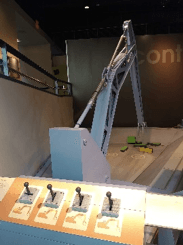
On Sunday, during our free sight-seeing time in Philadelphia, some of us went to Eastern State Penitentiary Historic Site and, if you go, I recommend using the audio guide. It is all in English but listenable and clear. You can learn about how criminals lived inside this prison during it’s long history. Also, there was a data shown how much penitentiary cost, how many people were imprisoned, and the facts hidden in our unconscious mind.
I also went to the Franklin Institute Science Museum by myself. It was a very exciting place for everyone – kids, scientists and engineers. All of the exhibits were made to be engaging or pull out children’ curiosity towards science. It was awesome and enjoyable. I especially liked the Amazing Machine exhibit. There were many cool stuffs that we could touch and feel that showed machines are cool and fun to study. There were also many types of controlled machines which we can control and play with. I think children can have fun learning by doing through these contexts and touching the exhibits. I saw many adults were having fun too. I recognized that Mechanical Engineering is a cool thing to do and my motivation towards all machinery rose again.
At Lehigh University we took the Strengths Finder assessment which was totally new and interesting for me. When I was unsure how my five strengths connected with each other, one of the other Japanese Fellows described the connections they saw between my strengths to me. I couldn’t think like she does, and that perspective was new for me. I want to use this result as part of my business card and remind myself that I am a good Inputter to utilize my strengths in the future.
The dinner session with Lehigh undergraduate students was also a stimulating event! One of the Lehigh students was from Massachusetts and I stayed in Massachusetts for a month, so we talked a lot about this. I was surprised that she is sophomore, which is same as me, and she had already experienced an internship at a company. She said it is rare in U.S. too, but I was so surprised with her strong motive in industry. I was stimulated by this, so I felt I may have to join many kinds of internships. It was great opportunity to talk with students of the same age and know what they are thinking about their careers.
Program in Washington, DC
Mr. Kei Koizumi’s talk at the American Association for the Advancement of Science (AAAS) was very interesting. I was happy to know about the Science Advisors in The White House and how science policies were made in there. I wanted to know more about AAAS and hear about Mr. Koizumi’s talk.
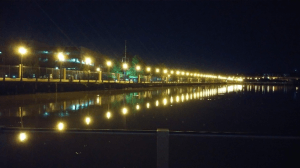
In Washington, DC, our tour of the United States Library of Congress was also very interesting. The inside was very beautiful and decorative and there were lots of hidden messages and stories in the building. The library has both an academic message and sculptural beauty. I was surprised that there were so many original buildings left in D.C. That is impossible in Japan due to earthquakes and natural disasters.
During our free time in DC, we went to eat dinner near Navy Yard and the night scene near harbor was very beautiful! I was impressed with that scene. The Night Bus Tour was also very fun! Seeing the monument lit up at night was incredibly beautiful. The Lincoln Memorial and Washington Monument were glowing white in the dark and so beautiful. I also enjoyed visiting the National Air & Space Museum. I wish I had more time to visit other Smithsonian museums too. I could only go to that museum, so I needed more time and I was sad about that. I also went to shop at Target to find some cute Halloween snacks for souvenirs. The packages were pretty and cheap. With our Big Bus tickets we got free admission to Madame Tussauds in DC and that was also a fun place to visit. There were many waxworks displayed inside the museum. I could take many photos or take selfies with The United States’ Presidents and many celebrities such as Taylor Swift and Zach Efron. I liked my picture with Lincoln the best. Also, it was a fun time spending with one of the graduate students we met during our visit at Howard University. We went to have lunch together and enjoyed the Big Bus tour together too. She taught us many things to about apply for graduate school in the U.S. and life in D.C.
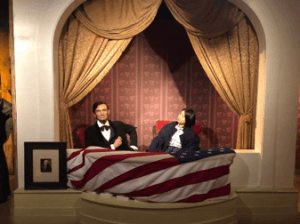
When I was leaving U.S, I just didn’t want to leave. I wanted to remain in U.S. not just because I don’t want to head back to school. I like to be in U.S. because I can be myself and express myself without any hesitation. When I’m back in Japan, I sometimes feel suppressed when I perform well. I feel like I can’t be outstanding or express my unique achievements. In the U.S, it is totally the opposite. The person who speaks out takes the chance. I think American attitudes are reasonable and fit me a bit better than the Japanese style. I will miss the American style of thinking and ethnic diversity in U.S. In my home university, everybody looks the same and speaks the same language. I felt that this is quite an awkward thing. If you want to work worldwide, I think it is necessary to engage with many types of people since there are many kinds of people in the world. I thought that if I remain in this homogenous environment, it will be hard to become a future global leader.
Final Report
When speaking with a family member, I would say the most important thing I learned was about the importance of networking with people. During this program, I met many people who were very unique and interesting to talk with. Before meeting with the other Japanese Fellows, I was impressed by their university names and I thought “Wow, they’re so smart and intelligent. Am I really going to be able to work together with them?”. After I met them, my worries disappeared. They were all so nice and not boastful about their schools but eager to seek out stimulating chances. I learned many things from them such as improving my attitude towards study, curiosity towards science, and knowledge of their fields of study.
When speaking with a professor, I would say the process of doing a research was the most important thing I learned. Doing research was challenging every day and I faced a lot of setbacks and difficulties. Some days, I was stuck by a single bug and could never find the possible solution. On the other hand, there were a few days that my research went well and I felt that it made my day. Those two feelings were continuously shifting day by day. I know that it is hard to concentrate on research but if I have a longer time to work on my project, then I think I would do a good job since I have no time restrictions. I want to do the research again more on my pace rather than just for five-weeks..
When speaking with an employer, I would say developing my problem solving skill was the most important thing that I learned from this program. During research, I faced lots of difficulties and experienced lots of setbacks. I tried to solve these problems by myself as much as I could. I learned how to solve the problems alone in any situation. Sometimes, I relied on my mentor and asked him for some help. Thus, I think I am not overly self-confident but know how to trust and look for help when needed. I think this skill can be used for any field of industry or business, so this problem solving skill is important as an employee.
Follow-on Project
I posted several times on my Instagram and Facebook about my experience and some of my friends told me that they were interested in this program and trying to apply for Nakatani RIES next year. I told them that I’ll support and help them. I will also invite several students from my high school and talk about my experience. I also have to visit my high school and talk about my experience since my teachers helped me out with the essay and the recommendation letter.
I will also contact to my faculty’s office and professors and tell them more about this program. Since I got this information from an unofficial mailing list from other faculty, I have to explain to my faculty how this program positively changed my life. I will also contact to my university’s international office and talk about my experience to make this program known by many students at my home university.
Tips for Future Participants
- Packing: You don’t need to pack so much. I brought many things that I didn’t need like tissue box. Also, I should have brought more pairs of underwear. Bring at least eight sets, because you will be too tired to do laundry some days.
- Communicating in English and Working with Your Research Lab: If you show that you want to have talk with the members of your lab, they will notice it. Once you show the attitude that you want to belong as the lab member or a part of the community, they will welcome you. You don’t have to worry about having a communication.
- Things to do at Rice University or in Houston: You have to go to The Houston Museum of Natural Science. It a good place to go as a scientist! Go to Rice Village also. There are lots of delicious restaurants! I recommend the Mexican restaurant (sorry forgot the name…it’s near Baskin Robbins). I also recommend going to the Katy Mills Outlet Mall! You can buy lots of American brand goods cheaper than in Japan! (Like Coach, Michael Kors, Mac, etc.). You can go there by Uber/Lyft but be careful that they might pick up other customer instead of just you! Just check if they got your name and direction.
